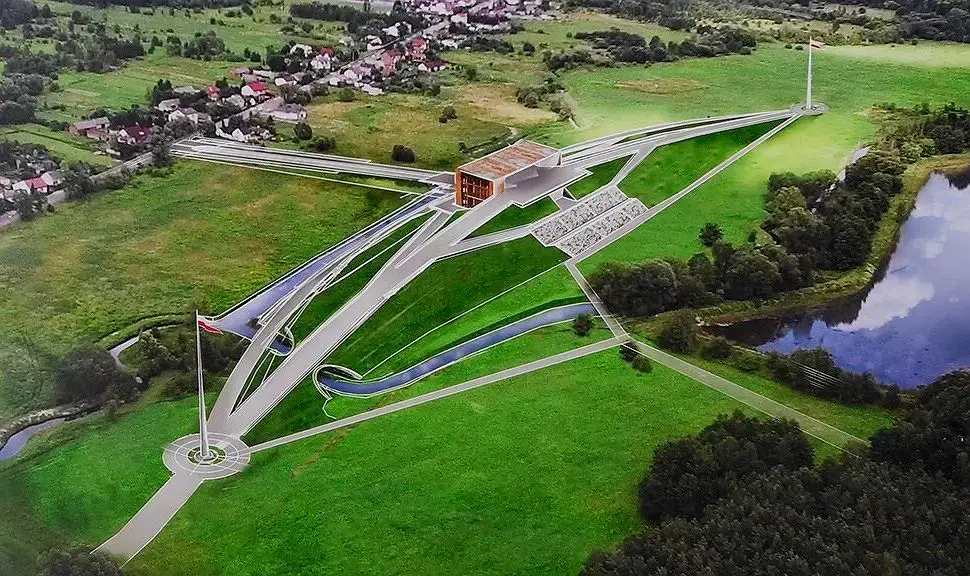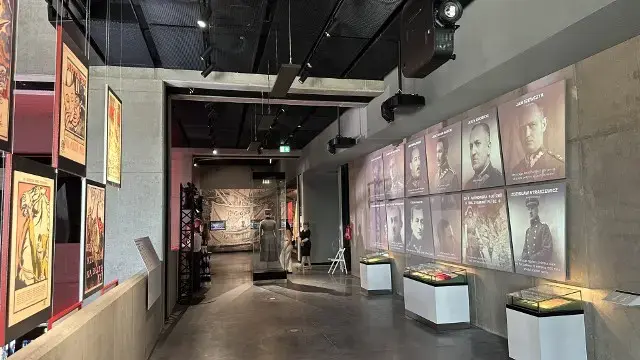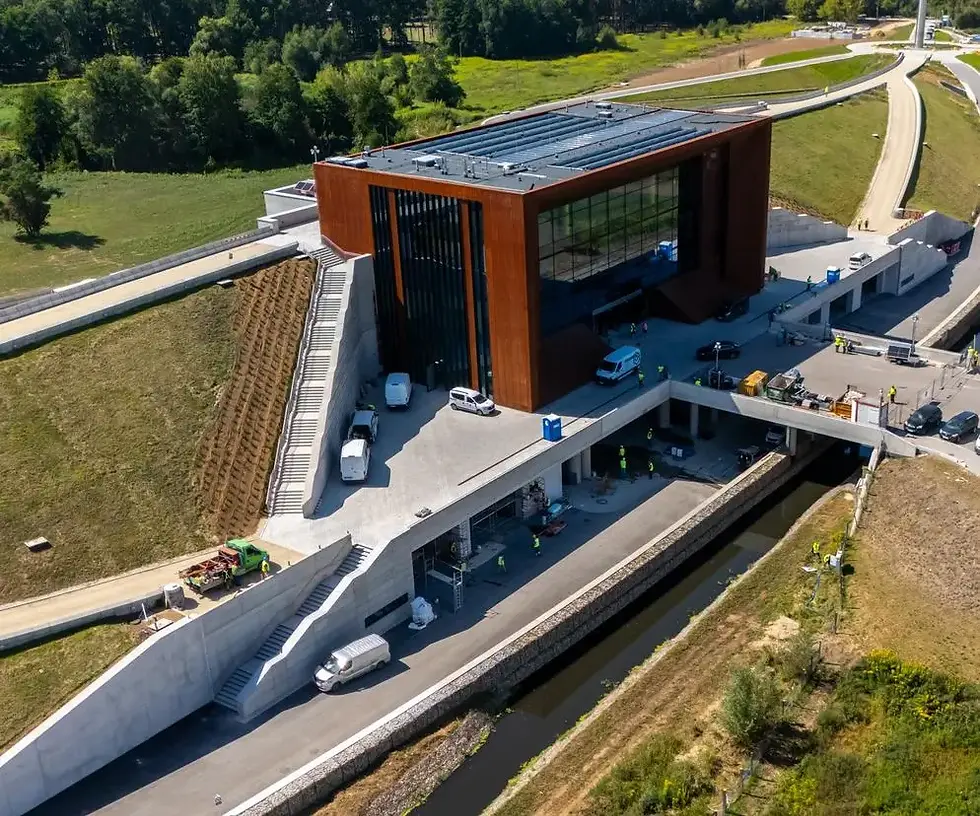Museum of the Battle of Warsaw 1920 in Ossów: A new museum on the map of Poland
- Damian Brzeski

- Sep 6
- 12 min read
Did you know that in the Ossów fields – where the Red Army's march was stopped – a 17-meter-high "mound" with two 70-meter-high flags was built, leading straight to the heart of history?
Here, the modern exhibition "UNITED, INVINCIBLE" combines original artifacts with immersive technology, and Piłsudski, Rozwadowski and Fr.
Skorupka returns to the front lines. What does the legend of the "Miracle on the Vistula" sound like when it speaks from the authentic battlefield? Step inside and see what the textbooks won't reveal.
The establishment and location of the museum: A new museum on the map of Poland
Permanent exhibition and museum collections: what will you see at the Battle of Warsaw Museum?
Education and accompanying events at the Battle of Warsaw Museum in Ossów
What is the significance of the Museum of the Battle of Warsaw 1920 for national memory?
Practical information for those planning a visit to the Museum of the Battle of Warsaw 1920

The establishment and location of the museum: A new museum on the map of Poland
Every great project has a beginning, and the history of the Battle of Warsaw Museum is a story of determination and the power of symbols.
This is not a random investment, but a well-thought-out action by the state, the aim of which was to pay due tribute to one of the most important events in Polish history.
Construction history and opening in 2025
The path to this impressive structure was the culmination of many years of effort. The formal process began in the summer of 2020, symbolically coinciding with the centenary of the battle.
On July 3, 2020, the Masovian Voivode issued a key decision on the building permit, and just a few days later, on July 9, the investor – the Polish Army Museum – signed an agreement with the general contractor, the state-owned company AMW SINEVIA.
The actual start of construction, announced by the then Minister of National Defence Mariusz Błaszczak, took place on August 3, 2020 .
The first shovelful of earth in the Ossów fields had not only a structural but, above all, a historical significance. It was a clear signal that the Polish state was fully committed to preserving the memory of its heroes.
After five years of intensive work, the museum opened its doors in August 2025, on the 105th anniversary of the "Miracle on the Vistula." The grand opening was a state-level event.
The symbolic cutting of the white and red ribbon was performed by Deputy Prime Minister Władysław Kosiniak-Kamysz , and Bishop Romuald Kamiński consecrated the new facility.
The museum became available to the general public for the first time on August 16, 2025, thus beginning a new chapter in the history of Polish museology.
Ossów as a place of remembrance of the Battle of Warsaw
Why Ossów? The choice of this location is as obvious as it is profoundly moving. Ossów is not a place beside a battlefield. Ossów is a battlefield.
It was here, on the eastern outskirts of the capital, that some of the most dramatic and decisive battles took place on August 13-14, 1920. It was on this soil that the Red Army first felt the bitter sting of defeat, and its advance toward Warsaw was bloodily halted.
It was here that the chaplain of the 236th Infantry Regiment, Father Ignacy Skorupka, fell , leading a counterattack by young, volunteer soldiers. His death became one of the most powerful symbols of the Battle of Warsaw – a sign of national unity, unwavering faith, and sacrifice made on the altar of the Fatherland.
The architectural concept envisioned an inextricable connection between a modern building and an authentic space of historical struggle. Standing on the museum grounds, you tread ground sanctified by the blood of heroes.
The role of the Polish Army Museum as a superior institution
The Ossów Museum is not an independent, local initiative. It is a modern and prestigious branch of the Polish Army Museum in Warsaw.
Such membership is a guarantee of the highest level of expertise, access to priceless national collections and professionalism in every respect.
It was the Polish Army Museum that appointed a special team tasked with developing the concept of the permanent exhibition, ensuring its historical accuracy and world-class quality.
As Sławomir Cenckiewicz aptly put it, the museum has a "pan-Polish" character . This means that its narrative transcends local events, telling the story of the entire nation's collective effort to defend independence.
A place that unites, showing that the victory in 1920 was the work of millions of Poles.

Architecture and symbolism of space
The museum building and its surroundings are more than just a functional space. They are a carefully considered story, one that begins long before you even cross the threshold. The architecture itself conveys the idea of victory and national pride.
Designed by Czesław Bielecki and executed by AMW Sinevia
The vision of this extraordinary place was created by one of the most outstanding Polish architects, Czesław Bielecki .
His goal wasn't to erect another pavilion, but to create a powerful "symbolic memorial complex" that would capture the emotions and imagination. The choice of his concept, while not the cheapest, demonstrates the importance placed on the project's artistic and symbolic power.
The implementation of this bold vision was entrusted to AMW Sinevia , a company belonging to the Military Property Agency, which guaranteed close cooperation with the Ministry of Defense. The total project cost was PLN 190 million.
Victory Alley and Victory Masts as national symbols
The experience of visiting the museum begins the moment you spot it on the horizon. The building was erected on a man-made, 17-meter-high hill , which towers like a barrow over the Masovian landscape, symbolizing the significance of the victory of 1920.
The broad, 500-meter-long "Victory Avenue" leads to the foot of the hill. Walking along it is a procession of sorts, a time for reflection and preparation for an encounter with great history. This deliberate action builds the mood and intensifies the feeling of experiencing something extraordinary.
The most spectacular element of the landscape, however, are the two gigantic, 70-meter-high "Victory Masts" .
The enormous red and white flags flying from them can be seen from miles away, serving as a powerful national symbol and clearly marking this place on the map of Poland. This is architecture that doesn't whisper, but proudly proclaims the message of the nation's strength.
Observation deck and amphitheater as elements of public space
Czesław Bielecki's design also features an open and visitor-friendly space. An integral part of the building is a spacious observation deck .
From here, a breathtaking panorama unfolds over the historic fields of Ossów. It is here that the museum's narrative merges with the authentic landscape, allowing us to imagine the uhlan charges and the heroic resistance of Polish soldiers.
Architectural renderings also show an open-air amphitheater , nestled into the hillside. This space was created with living culture and education in mind – a venue for concerts, lectures, and performances by reenactment groups.
Thanks to this, the museum becomes not only a treasury of the past, but also a vibrant cultural center.

Permanent exhibition and museum collections: what will you see at the Battle of Warsaw Museum?
After passing through the monumental outdoor space, it is time to immerse yourself in the heart of the museum – the permanent exhibition that tells the story of one of the most important victories in world history in a modern and captivating way.
Interactive exhibition about the Battle of Warsaw 1920
The permanent exhibition, meaningfully titled "UNITED, INVINCIBLE," occupies an impressive 1,000 square meters . The name itself introduces the narrative's central theme – the strength of the Polish nation found in unity.
Forget dusty display cases and monotonous descriptions. This is a 21st-century museum that focuses on immersing yourself in history .
The creators have masterfully combined priceless, original exhibits with the latest technologies to transport visitors to the heart of the events of 1920. Large-scale projections with mapping, interactive stations, including a virtual shooting range , and the sounds of the battlefield all around await you.
This is a conscious strategy that aims not only to convey knowledge, but above all to stir emotions.
Among the multimedia attractions, you'll also find reconstructed battle stations, animated tactical maps , and archival footage of eyewitness accounts of the day. All of this makes history tangible and understandable like never before.
Exhibits from the Polish Army Museum and the Cultural Park "Ossów – Gateway to the Battle of Warsaw"
The power of any historical exhibition lies in its authentic artifacts, and in Ossów you'll be able to experience true treasures. The core of the collection consists of dozens of unique artifacts from the extensive collections of the Polish Army Museum.
However, what gives this exhibition a unique, local dimension is the inclusion of exhibits collected by the Local Government Cultural Institution "Cultural Park – Ossów – Gateway to the Battle of Warsaw" .
These are often objects excavated from the Ossów soil, souvenirs donated by the families of the battle participants – silent witnesses who can now tell their story to the entire nation.
Selected objects: de Bange's cannon, regimental banners, painting by Kazimierz Kwiatkowski
Among the hundreds of fascinating objects, several deserve special attention. Your attention will certainly be drawn to the powerful French siege cannon of the de Bange system .
It is not only an impressive example of military technology, but also a symbol of the crucial support that France provided to Poland.
A crucial element of the exhibition are regimental banners – the most sacred relics of any army. The museum displays both the banners of Polish units and the most valuable trophies – the banners captured from the Bolsheviks . Their presence in the exhibition is a tangible symbol of the Polish triumph.
Although the materials do not mention a specific painting by Kazimierz Kwiatkowski, the presence of battle paintings in this type of institution is essential.
Great historical canvases have shaped the imagination of Poles for decades and built the legend of the "Miracle on the Vistula," and their artistic vision perfectly complements the historical narrative.
In addition, the exhibition will feature a rich collection of uniforms and weapons from both sides , as well as extremely interesting Polish and Bolshevik propaganda posters that perfectly reflect the ideological dimension of this clash of civilizations.

Heroes of the Battle of Warsaw presented in the museum
History is not just about dates and troop movements. It is, above all, about people – their courage, decisions, and sacrifices. The Ossów Museum masterfully personalizes the story of the battle, presenting the figures of its key figures.
Józef Piłsudski and his role in the victory
The central place in the narrative is, of course, occupied by the figure of the Commander-in-Chief, Marshal Józef Piłsudski .
It was his bold plan for a counteroffensive from the Wieprz River that tipped the scales of victory. The exhibition features his original military coat and famous "Maciejówka" cap – personal items that bore witness to historic decisions.
A visit to Ossów is a perfect complement to a visit to the nearby Józef Piłsudski Museum in Sulejówek.
Ignacy Skorupka as a symbol of sacrifice and faith
A hero inextricably linked to Ossów is Father Ignacy Skorupka . He is the heart of a local story that, thanks to the museum, has gained a national dimension. He has become a symbol of the nation's spiritual strength.
The museum houses priceless relics associated with him: the stole he wore and the Passion Cross (pectoral cross) that accompanied him at the moment of his death. These humble objects possess extraordinary power, transforming history into a narrative of martyrdom.
Generals Latinik and Rozwadowski – commanders and their legacy
The museum pays tribute not only to commanders-in-chief but also to front-line commanders. It commemorates General Franciszek Latinik , commander of the 1st Army, responsible for the defense of the crucial Warsaw Bridgehead.
However, one of the museum's most important missions is to restore General Tadeusz Rozwadowski to his rightful place in history . For decades, his role was marginalized.
Today, thanks to the museum's narrative, we can recognize him as the true architect of the operational plan for the Battle of Warsaw . As Chief of the General Staff, he was the mastermind of the operation, developing the details of the maneuver that led to victory. The Ossów Museum boldly undertakes the task of historical correction, paying tribute to the unsung hero of the "Miracle on the Vistula."

Education and accompanying events at the Battle of Warsaw Museum in Ossów
The Battle of Warsaw Museum is a vibrant institution year-round. It's not just a place to visit, but above all, a center for actively experiencing history, making it worth returning to.
Reenactment of the Battle of Warsaw and a historical-military picnic
The absolute highlight of the events calendar is the spectacular annual reconstruction of the Battle of Warsaw , held in mid-August.
This is a must-see spectacle. On the historic fields of Ossów, accompanied by professional pyrotechnics, scenes from over a hundred years ago come to life.
The scale of this event is impressive: it features approximately 150 reenactors, 50 horses, and replicas of historical vehicles , including the legendary Renault FT tank. The reenactment is part of a larger, two-day historical and military picnic .
During the event, you can admire demonstrations of modern Polish Army equipment and, of course, taste traditional military pea soup!
"Become a Volunteer 1920" field game and interactive 3D/VR tour
The museum has a fantastic offering for families and young people. One of the biggest attractions at the picnic is the "Become a Volunteer 1920" field game . Participants receive a "mobilization card" and visit subsequent locations, completing tasks and learning about the realities of service. It's a perfect example of learning through play.
The facility also keeps up with the times by offering modern digital tools. You can take an interactive 3D/VR tour of the battlefield or view digitized exhibits in 3D on your smartphone.
Collaboration with the Grom. Strength and Honor Foundation
The high standard of the annual reenactment is due to our collaboration with a renowned partner – the GROM Strength and Honor Foundation .
The Foundation, established by relatives of General Sławomir Petelicki, brings military precision and attention to historical detail to the event.
This collaboration guarantees that the show is not only impressive, but also as faithful to reality as possible.

What is the significance of the Museum of the Battle of Warsaw 1920 for national memory?
The opening of the Battle of Warsaw Museum in Ossów is an event of fundamental importance for Polish national memory and identity.
Commemoration of the Battle of Warsaw as the "Miracle on the Vistula"
The museum permanently and monumentally commemorates the battle, which was one of the key clashes in the history of the 20th century.
This victory saved Poland's newly regained independence and halted the communist revolution's march westward , preserving all of European civilization. The museum serves as a guardian of this memory, reminding future generations of the significance of those events.
Connection with the celebration of Polish Army Day
The date of the main celebrations is no coincidence. On August 15 , the anniversary of the turning point of the battle, Poland celebrates Polish Armed Forces Day.
The Ossów Museum, with its spectacular reconstructions, becomes a natural heart of these celebrations, alongside the Warsaw parade. It is a place to which patriots from across the country make pilgrimages on this special day.
The planned honoring of General Rozwadowski with the Order of the White Eagle and a monument
The museum also became a catalyst for the full historical rehabilitation of General Tadeusz Rozwadowski. His role, so strongly emphasized in the museum's narrative, inspired public debate.
During the museum's opening ceremony, an important declaration was made: the first monument to General Rozwadowski in Poland will be erected in Warsaw, in front of the General Staff headquarters . This is a symbolic act of historical justice, rooted in the work of historians associated with Ossów.

Practical information for those planning a visit to the Museum of the Battle of Warsaw 1920
To help you plan this extraordinary journey through time, we have collected all the necessary practical information.
Museum in a Nutshell – Address and opening hours
Category | Information |
Address | ul. Stanisława Matarewicza 188, 05-230 Ossów |
Opening Hours (August) | Tuesday - Thursday: 3:00 PM - 9:00 PM, Friday - Sunday: 10:00 AM - 6:00 PM, Mondays: closed |
Tickets | Regular: PLN 40, Concession: PLN 30 (from September). Free admission throughout August 2025. |
Reservations and Contact | Tel: 570 965 500 (8:00–15:00), Email: rezerwacjeossow@muzeumwp.pl |
Availability | Accessible for people with disabilities, entry with an assistance dog allowed. |
Opening hours and exhibition availability
The museum is open to visitors year-round, but opening hours are subject to change. It's always worth checking the official website for up-to-date information . The hours listed in the table are for the inaugural month – August 2025.
Ticket prices, valid from September 2025, are PLN 40 for a standard ticket and PLN 30 for a reduced ticket .
The facility is fully accessible to people with disabilities , and you can enter it with an assistance dog.
How to get to the museum?
Located just 22 km from the centre of Warsaw, Ossów can be easily reached in several ways.
By car: The easiest way to get there from Warsaw is via provincial road 634 towards Wołomin. Parking is available near the museum.
By public transport:
By train: Take the Koleje Mazowieckie train and go to the Kobyłka Ossów station.
By bus: Local buses run from the train station to the museum. Special, free buses are often run on major event days.
On-site tourists have access to the Tourist and Historical Information Centre , as well as a café and a souvenir shop.
Recommendations for families, schools and organized groups
The Battle of Warsaw Museum is the perfect place for a trip for everyone.
For families: We highly recommend visiting in mid-August to participate in the historical picnic and field game . The interactive nature of the exhibition is sure to delight older children and young adults.
For schools and groups: The museum offers a wide range of educational opportunities. You can book guided tours, film screenings, or a live history lesson with a reenactor. Group reservations can be made by phone or email.
Ladies and Gentlemen, a visit to the Battle of Warsaw Museum in Ossów is more than just sightseeing.
A visit to the museum is a journey to the sources of Polish pride, a tribute to heroes, and an unforgettable experience that allows us to understand the great price of freedom.
Don't hesitate – add this place to your must-see list. I guarantee you won't regret it.
































































Comments